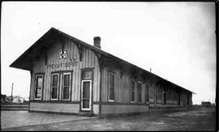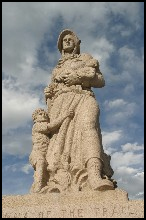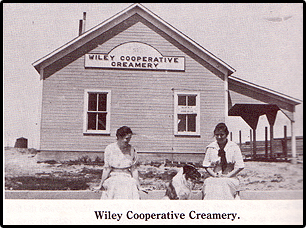| Towns in Prowers County |
| Lamar - Holly - Granada - Wiley |
  Located in Prowers County in Southeast Colorado, Lamar has a wealth of churches, great schools, some of the finest athletic programs around, and recreational outlets. We are only minutes away from lakes and under four hours from Denver. Lamar boasts a thriving economy . There are three radio stations with a variety of music, a community college, golf course, and even a movie theatre downtown. Lamar also has plenty of shopping available with the downtown merchants, Alco, Walmart, major fast-food restaurants, grocery stores, pharmacies and much more. Prowers Medical Center provides health care for Lamar and surrounding communities. Lamar is a great place to live and work. Kansas, Oklahoma, and Texas are our immediate neighbors.  As the rail lines winded westward new towns came into being, some of their own accord, others through the efforts of "town site platters". The far west saw much of these promoters during the seventies and eighties. When a location was selected, though often through connivance, a railway station was built. Thus the story of the founding of Lamar Begins. There was a station on the Santa Fe Trail known as Blackwell, designated as railroad mile post 499, the distance from Atchison, Kansas. It was merely a small depot and stock yards siding. On either side of the track were the holdings of A. R. Black, a cattleman of very extensive operations, whose home and ranch quarters were located nearby. The location was ideal for running cattle. To the south was an unlimited areas of rich grass land and to the north the Arkansas River with its forest of cottonwood and plum trees which furnished water refuge for cattle during winter weather. A small irrigation ditch furnished water for raising grain crops, prairie hay could be harvested from the low land. Mr. Black was typical of the prosperous cattleman of his period. To him the vast plains area was only intended for grazing and he had little or no patience with farming. Typical of large land holders he became annoyed with the ever increasing arrival of homesteaders. The railway station gave him easy access to the county seat at Las Animas or occasional trips to Denver, or perhaps to that newer town of Pueblo. Mr. Black was living in an area which was destined to change. There was a decided movement of population westward which was being taken advantage of by the town promoters. This gentry might not be considered entirely ethical in present day light, but men in the past century were not always endowed with to many qualms. If there was profit to be had in starting a town, a town would be started. During that period the town site business had been flourishing, so flourishing in fact that the promoters had nearly run out of town site possibilities, but an opportunity did present itself in eastern Colorado and that opportunity was Blackwell. Early in 1866 Mr. Black was approached, it is stated, to donate certain of his lands adjacent to Blackwell as a town site. In return he was to reap a substantial profit from the sale of town lots constituting property which  he retained. Mr. Black refused to consider any proposition whatever, although he was threatened that another town would be started close by and his depot moved. Mr. Black considered this a bluff. No one could start a town where would the people come from? Shortly however, the promoters had found a man with title to land in section 31, three miles west, who was willing to sell and did. Worse, yet, the depot was to be moved. Mr. Black immediately boarded a train for Denver, consulted his lawyer and prepared to secure an injunction. The next day was Sunday and since the injunction was issued Monday, Sunday was used by a wrecking crew of the railroad to move the Blackwell depot three miles west to mile post 502. They threw aside the Blackwell sign and exhibited the name Lamar and so Lamar was born, May 24, 1886. he retained. Mr. Black refused to consider any proposition whatever, although he was threatened that another town would be started close by and his depot moved. Mr. Black considered this a bluff. No one could start a town where would the people come from? Shortly however, the promoters had found a man with title to land in section 31, three miles west, who was willing to sell and did. Worse, yet, the depot was to be moved. Mr. Black immediately boarded a train for Denver, consulted his lawyer and prepared to secure an injunction. The next day was Sunday and since the injunction was issued Monday, Sunday was used by a wrecking crew of the railroad to move the Blackwell depot three miles west to mile post 502. They threw aside the Blackwell sign and exhibited the name Lamar and so Lamar was born, May 24, 1886. The new city was named after Lucius Quintius Lamar, Secretary of the Interior under Grover Cleveland. The name Lamar was used successfully in order to secure a land office. Thus Lamar came into being with all of the usual fanfare and advertising of the time. Likewise came the people, enticed by the thought of free land, and town lots soared to a new high. For a couple of years Lamar enjoyed a very hectic career. It was the last town to be established in this fashion and it is the youngest town of an consequence on the main line of the Santa Fe. Lamar is the County Seat of Prowers County with agriculture as its main industry. |
| Lamar - Holly - Granada - Wiley |

 Holly began in 1871 when Mr. Hiram S. Holly started up his SS Ranch here. Holly was named for this man who served with the Twenty-Eighth Connecticut Volunteer Infantry. He came to Colorado after he was discharged and began to work cattle. He sold out in 1883 to an English Company named the Arkansas Land and Cattle Company. It began in 1871, the stone ranch house and barn, known as the SS Ranch. Mr. Hiram S. Holly, for whom the town was named, had served with the Twenty-Eighth Connecticut Volunteer Infantry, and after his discharge, he eventually arrived in Eastern Colorado with 1300 head of mixed cattle. The ranch changed hands in 1883 when Mr. Holly and his partners sold it to an English Company under the name of the Arkansas Land and Cattle Company. The ranch eventually grew to be one of the largest cattle ranches in the West, encompassing nearly 2,500,000 acres of land. Back in the early days, ranch headquarters acted as community centers, not only for those employed at the ranch, but also for neighboring homesteads. The centers not only provided many services, but in many cases, sold supplies and food. The SS Ranch was one of these community centers, or service centers, that grew to be the small town of Holly. There was a post office as early as 1893, but Holly was officially assigned a post office in 1900. The first telephone switchboard was installed in 1902. The first waterworks and electric light plant was installed in 1911. The first established church organization was the Presbyterian Church of Holly, which dates back to September, 1900. The First Methodist Church of Holly, however, was holding services in 1898. There was a railroad depot as early as 1896. SCHOOLS Little Red School House on the SS Ranch Horse Creek School-also called Headwater School Holly School-1891 Holly Union Central School-1898 Holly Union High School-First graduate was May Emery in 1906. Prairie View School-located north of Holly |
| Lamar - Holly - Granada - Wiley |
  The town of Granada saw many changes in the beginning, mostly name changes, but even the site changed. In 1872, a commisary and store had been built by T.B. Nolan, and Chick, Brown & Co. of Kit Carson, a mercantile firm, began laying out a town. Grenada was platted on June 10, 1873 in Bent County, about 12 miles west of the Kansas state line. It began about the time the Atchison, Topeka, and Santa Fe Railroad arrived in Colorado. Because railroad funding ran out, Granada could have become a ghost town, but instead, became a thriving community. It was the second largest community (Las Animas was the largest) in Bent County, and one of the largest in the state by 1876. A post office was established in August 1873 and by 1874, Granada had a public school, two hotels, three grocery stores with hardwares, a drug store and several restaurants. The majority of the population was made of railroad employees, miners, cowboys, freight employees and gamblers, totalling about 1500. There was very few church activities and a newspaper had not yet been established. The only law enforcement was the marshal. Old Granada, as it was later known, was never incorporated. Since the railroad had laid its tracks on the north side of the Arkansas River and Granada was built on the south, a railroad bridge was built. They also added an extension so that wagons could use the bridge. The A.T.&S.F. stationed Adam D. Snowden, an employee, to collect tolls and protect it from hazards such as prairie fires. The railroads coming into Colorado caused the buffalo herds to separate. The southern herd was thick south of the Arkansas River, but north of the Canadian River. Granada became a popular site for buffalo hunters. It was the central shipping location for eastern markets. Hundreds of freight wagons could be seen camped at or near Granada. The Kansas Pacific railroad was also laying track from Kit Carson to La Junta, and competition between La Junta and Granada began for the New Mexico trade. A second mercantile moved to Granada by the name of Otero, Sellar and Company, and along with Chick, Brown and Company received their goods by rail in Granada. They sent their freight to Santa Fe by ox teams. Old Granada was abandoned because it wanted to grow. When the railroad continued west, the town lost much of its population. It still had a post office, school house, a few houses and a store. The railroad station was still there as well as a hotel and saloons. It continued to function as a town until 1885. Besides the railroad, another possible reason for its demise was a real estate purchase. The Chick, Brown and Company land, the XY Ranch, and other land, about 3,000 acres, was purchased by an entreprenuer named Frederick H. Harvey. The land extended from the river bridge to the present town of Granada, land that basically surrounded Old Granada. Mr. Harvey of the Harvey House Restaurants was in partnership with the Santa Fe Railroad to feed its passengers along the line. By now, rumors that a U.S. land office was to be established in the area, prompted Granada businessmen to ask Mr. Harvey about selling some of his land to expand Granada. Mr. Harvey was unwilling so it was decided to move the town to another location that could accommodate growth. After thirteen years, the town was hauled three miles west near Wolf Creek. The new location was land homesteaded by William Grooms and purchased by the Bent County Town Company on April 26, 1886. The Bent County Town Company listed Thomas Doak as president, A.D. Snowden as secretary, and listed D.A. Mims, E.N. Keep and Dickinson. Not only were many of the buildings moved from the old site but the surveyors borrowed the plat. The railroad station remained at Old Grenada on the XY Ranch but the Santa Fe Railroad renamed it Adana. As the new town was getting under way, a meeting of its citizens decided that the most important need was a school. A proposal was made to collect funds to build a school house but another suggestion was made that a seldom used schoolhouse east of Granada on the XY Ranch, be swiped. It was, and an extra room was added on immediately. The first teacher was C.O. Barton. A petition to incorporate the town was submitted to the Bent County Judge on June 10, 1887 and an election was held July 5, 1887 with 18 for incorporation and 7 against. After all legal notifications were made, the town was declared incorporated on July 23, 1887. They still lacked a railroad station so the town fathers suggested that the Santa Fe Railroad officials move the station from Old Grenada to New Granada. The officials decided that the depot would move if they received 51% of all unsold lots and 51% of money already received on lot sales in the new town. The town leaders felt they had already paid their dues at Old Granada so they refused. The Santa Fe Railroad bided its time and then sent surveyors in the location to become Lamar. Lamar was also to be the new location of the U.S. Land Office. The town, in 1886, managed to be assigned as a railroad switch so that even if there wasn't a depot at least trains stopped. The frontier life that was the environment in Old Grenada continued in New Granada. There were several saloons and many confrontations. In the first six months, "12 men died with their boots on". At the time, Granada had more shootings and fatalities than any other town in Prowers County. The unsavory reputation put a damper on any settlers coming in to homestead the land. By September, 1887, the Santa Fe Railroad put a station in at Granada although their records do not list a station agent before 1890. In 1889, Prowers County was formed from Bent County, and so started the race for county seat. Granada's bid didn't pan out, instead going to Lamar. Old Grenada and the XY Ranch, was renamed Adana by the railroad, but in December, 1891, the U.S. Post Office changed the name to Byron. However, in January, 1892, it was discovered that the name was in use elsewhere and again changed the name, this time to Zuck. The name was less acceptable so the cowboys and homesteaders petitioned the government to change the name back to Byron. They were ignored until the turn of the century when the name was changed to Barton. The town was prospering until New Year's Day in 1893 when two major fires destroyed most of the business district. The first fire was believed to have originated in Mrs. Frank Barton's restaurant. Before the town had a chance to rebuild, another fire started April 17, 1893. This time it was believed to have originated in the drug store caused by spontaneous combustion. Most of the buildings involved had been moved from Old Grenada but the entire new town was built of wooden frame structures. Another fire was to destroy the business district in September, 1910. It began with the Exchange Saloon. There are few buildings left that date before 1900. Many of the business owners who were burned out chose not to rebuild and moved away. Granada continued to survive. The Colorado Telephone Company constructed a telephone exchange in March, 1903 and by June 10, 50 phones were working. Granada's first high school, the Granada Union High School, was built in 1903. The First National Bank of Granada was the first bank in Prowers County and had been established right after the town began. The first hotel was opened in 1886 known as Mim's House. With the start of World War II, a relocation center for the Japanese was constructed and opened on August 27, 1942, just southwest of Granada. It was named Camp Amache in honor of Amache Ochinee Prowers, wife of John W. Prowers, for whom the county was named. By September 30, 1942, the center was full. It was self-supporting and included a post office, fire station, police, schools and a 150-bed hospital. Today there is little evidence of the once thriving community that added to Granada's existence. By October, 1945, the project that included more than 10,000 acres, had been turned over to the Federal Land Bank of Wicheta, KS for disposal. Granada was to become a quiet agricultural community. Many buildings are still standing but empty, evidence of a once thriving town. |
| Lamar - Holly - Granada - Wiley |

 Wiley was founded in 1906 by the big Bend Town and Improvement Company and named after William M. Wiley of Holly. The town was named for William Wiley because it was hoped that he would eventually bring a sugar factory as well as a railroad to the area. The town did not appear to get underway until 1907. The area where Wiley sets today was also known as the Northside by most folks and then as Empire Valley in 1901. Telephone service came to Wiley (The North Side) in 1902 - the only Prowers County town outside of Lamar and Holly to have this luxury. In May of 1907, the State Bank of Wiley was incorporated, with H. G. Lamson as president. He was also Wiley's first Mayor. That same year, W. J. Blosser built the first brick building on Maine Street, Wiley Mercantile, and operated the first Post Office from there.  Wiley became an incorporated town Janurary 28, 1909. Next to sugar beets, alfalfa was an important crop to early Wiley and as the sugar beet industry dwindled in the Arkansas Valley, the hay industry took it's place in the Wiley area - now the annual fair is called Wiley Hay Day. |
| Lamar - Holly - Granada - Wiley |
| We are still working to aquire information on the rest of the towns in Prowers County. As soon as this happens we will post. If you have any images and/or information reguarding the other communities please contact us at (719) 688-2717. Thank You! | |